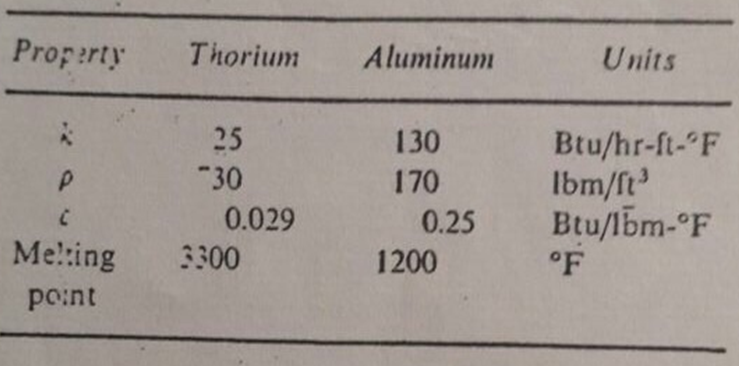Question
The cross section of a cylindrical fuel clement in a nuclear reactor is shown below. The element is designed to operate surrounded by a 200T
The cross section of a cylindrical fuel clement in a nuclear reactor is shown below. The element is designed to operate surrounded by a 200T coolant. An average heat-transfer coeE-cient between the cladding and the coolant is 1200 Btu/hr-ft 2 -?F.
The reactor safeguards committee is concerned about safety during start up of the reactor. When the control rods are suddenly pulled, and generation begins in the thorium, there is the possibility that if the rods are accidentally pulled too far and/or too fast there may not be time to correct the trouble before melting of either the thorium or the aluminum occurs. NELG is about to run a test program in which such a fuel element is suddenly exposed to a neutron source so that generation begins suddenly. The test exposure flux will produce a heat generation rate of 40,000 Btu/hr-in. 3 . The test will be controlled so that the ambient remains constant at 200 T (with h = 1200 Btu/hr-ft 2 ?F) and the fuel element will be initially at 200?F. You have been called in to estimate the length of time before 
ANALYTICAL MEHOSDS IN CONDUCTION HEAT TRANS
Melting will occur (if it does indeed occur at this generation rate).
Use the following properties in your calculations:

Thin aluminum cladding -1 in.- Thorium fuel rod Property P C Melting point Thorium 25 "30 0.029 3300 Aluminum 130 170 0.25 1200 Units Btu/hr-ft-'F Ibm/ft Btu/lbm-F F
Step by Step Solution
3.38 Rating (164 Votes )
There are 3 Steps involved in it
Step: 1
The computation are expressed below using heat conduction for the given dat...
Get Instant Access to Expert-Tailored Solutions
See step-by-step solutions with expert insights and AI powered tools for academic success
Step: 2

Step: 3

Ace Your Homework with AI
Get the answers you need in no time with our AI-driven, step-by-step assistance
Get Started


